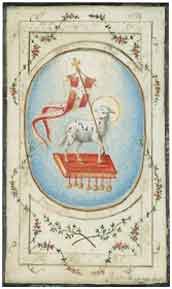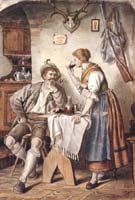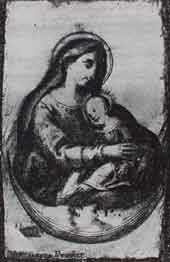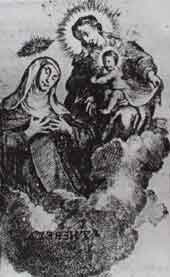|
|
||||
|
Painting on spiders' webs is a miniaturist art form
which began in the middle
of the
18th century, in the Pustertal region which was Austrian at the time. Later a few paintings were found at Salzburg, and towards the end of the
19th
Century, in northern Tyrol,
particularly at Innsbruck. Whilst the
Pustertal miniatures
had religious themes and were mostly destined for convents, presbyteries
and houses of the bourgeoisie, the artists of Innsbruck painted landscapes
and folk costumes, and military feats at the time of the wars of
independence. These
works were destined for tourists and art merchants and were
exported in great number to Germany, and especially to England and North
America. The Buritt
Monte Santo museum at Huntsville, Alabama, has several collections. The practice of this art by the artists was short and is summarized over the three following periods: 1 The old period 1740-1830 The practice of this art form did not last long. The painter Elias Prunner was the first artist to practice this miniature art form, and in 1765 he painted for Empress Maria Theresa. The most significant artists of this period are:
These painters all are localised in the valley of Pustertal 2
The intermediate period 1830-1870 The painters Qualities Käsebacher de Schwaz, Andreas Freiberger and the academic painter, Baronne Marie Sternbach living Hall in the Tyrol are mentioned in the writings as artists who ensured the practice and the transition about the third time. Over this period I have few information to give you, do not hesitate to contact me if you have some data and why not a painting. Thank you in advance. 3 The last period 1870-1920 Epoch
north-tyrolienne After religious themes, the favoured subjects were scenes of daily life. The industrial revolution gave many ideas to the artists because they would call on young peasants to collect the spiders' webs. On declaration of war in 1914 the practice obviously had to stop, and from 1920 onwards no new work has been found. |
|
In Brixen, in the Neustift abbey, two tables are on "cobweb"; both are watercolours and extremely damaged.
Unsigned painting
Maria and the child signed Prunner. Oldest and most known of the tables on cobwebs. |
||
|
|
||||
|
Not signed painting
|
||||

1790 Johann Burgmann painting on caterpillar silk.
|
||||





